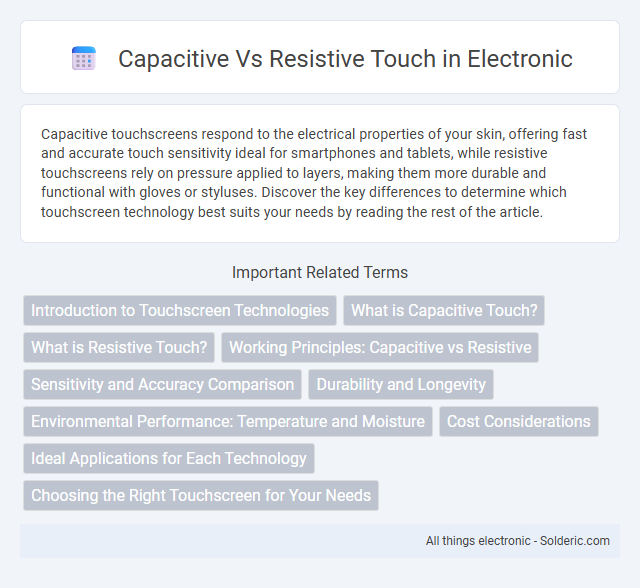Capacitive touchscreens respond to the electrical properties of your skin, offering fast and accurate touch sensitivity ideal for smartphones and tablets, while resistive touchscreens rely on pressure applied to layers, making them more durable and functional with gloves or styluses. Discover the key differences to determine which touchscreen technology best suits your needs by reading the rest of the article.
Comparison Table
| Feature | Capacitive Touch | Resistive Touch |
|---|---|---|
| Technology | Uses electrical conductivity of the human body | Uses pressure on two flexible layers |
| Touch Sensitivity | High sensitivity, supports multi-touch | Lower sensitivity, generally single touch |
| Durability | More durable, scratch-resistant glass | Less durable, prone to wear and tear |
| Input Method | Finger or conductive stylus | Finger, stylus, or any pointed object |
| Cost | Higher production cost | Lower production cost |
| Image Clarity | Better clarity due to glass layer | Reduced clarity because of multiple layers |
| Common Use | Smartphones, tablets, modern touchscreens | Industrial devices, GPS, older touchscreens |
Introduction to Touchscreen Technologies
Capacitive touchscreens utilize the electrical properties of the human body to detect touch, offering high sensitivity and multi-touch capabilities, making them ideal for smartphones and tablets. Resistive touchscreens rely on pressure applied to two conductive layers, enabling use with gloves or styluses but often with lower sensitivity and single-touch limitations. Both technologies play crucial roles in various applications, balancing cost, durability, and user interaction preferences.
What is Capacitive Touch?
Capacitive touch technology detects changes in the electrical field when a conductive object, such as a human finger, makes contact with the screen, enabling precise and multi-touch input recognition. This type of touchscreen is commonly used in smartphones, tablets, and advanced interactive displays due to its durability and responsiveness. Capacitive touchscreens generally offer higher sensitivity and better clarity compared to resistive touch panels, which rely on pressure detection.
What is Resistive Touch?
Resistive touch technology works by detecting pressure applied to the screen, where two flexible layers inside the display make contact to register input. This type of touch interface is highly accurate for stylus or gloved-finger use and is commonly found in industrial devices and older smartphones. Your choice of resistive touch screens can offer reliable performance in harsh environments where precise, pressure-based interaction is essential.
Working Principles: Capacitive vs Resistive
Capacitive touchscreens detect touch through the electrical properties of the human body, using a conductive layer to sense changes in the electrostatic field when a finger contacts the screen. Resistive touchscreens operate by detecting pressure applied to two flexible, electrically conductive layers separated by a small gap, which connect when pressed together. The capacitive method relies on capacitance changes, while the resistive method depends on physical pressure to register input.
Sensitivity and Accuracy Comparison
Capacitive touchscreens offer higher sensitivity and accuracy due to their ability to detect the electrical properties of the human finger, providing precise multi-touch support and faster response times. Resistive touchscreens rely on pressure applied to the screen surface, resulting in lower sensitivity and less accuracy, especially with light touches or gloved fingers. Capacitive technology excels in environments requiring fast, accurate input, while resistive screens may struggle with fine detail or rapid gestures.
Durability and Longevity
Capacitive touchscreens offer superior durability compared to resistive screens, as they rely on a glass surface that resists scratches and wear over time. Resistive touchscreens use multiple flexible layers that can degrade or lose sensitivity with repeated pressure, reducing their longevity. Your choice should consider that capacitive technology generally provides a longer lifespan in high-use environments.
Environmental Performance: Temperature and Moisture
Capacitive touchscreens offer superior performance in temperature fluctuations and high moisture environments due to their reliance on the electrical properties of the human body, maintaining responsiveness even when wet or exposed to extreme cold or heat. Resistive touchscreens, which depend on pressure applied to flexible layers, often suffer reduced sensitivity and accuracy under moisture exposure and extreme temperature conditions, leading to potential malfunction or slower response times. Devices using capacitive technology are generally more reliable in harsh environmental conditions, making them suitable for outdoor or industrial applications where temperature and humidity vary widely.
Cost Considerations
Capacitive touchscreens generally have higher initial costs due to advanced materials like indium tin oxide and complex manufacturing processes, but they offer greater durability and sensitivity, reducing long-term maintenance expenses. Resistive touchscreens are more affordable upfront, making them ideal for budget-conscious projects, while their simpler design involves flexible layers that can wear out faster and may require more frequent replacements. Your choice depends on balancing upfront investment against lifespan and performance needs in your specific application.
Ideal Applications for Each Technology
Capacitive touchscreens excel in environments requiring multi-touch functionality and high sensitivity, making them ideal for smartphones, tablets, and interactive kiosks. Resistive touchscreens perform best in industrial settings where gloves or styluses are used, suitable for machinery controls and medical devices due to their durability and accuracy with various input methods. Each technology serves specific use cases based on responsiveness, environmental conditions, and input requirements.
Choosing the Right Touchscreen for Your Needs
Capacitive touchscreens offer high sensitivity and multi-touch support, making them ideal for smartphones and tablets requiring precise gestures and smooth user interaction. Resistive touchscreens function through pressure, making them suitable for industrial environments, medical devices, and scenarios where users wear gloves or use a stylus. Selecting the right touchscreen depends on factors like durability, environmental conditions, and desired input methods to ensure optimal performance.
Capacitive vs Resistive Touch Infographic

 solderic.com
solderic.com